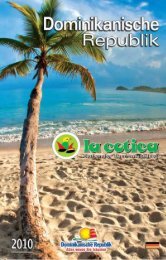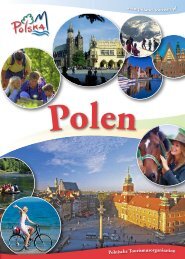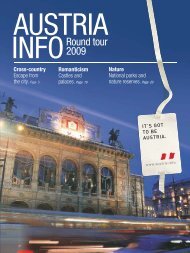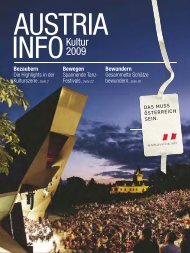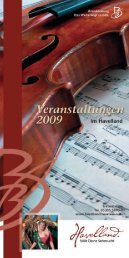i Dominican Republic - travelfilm.de
i Dominican Republic - travelfilm.de
i Dominican Republic - travelfilm.de
You also want an ePaper? Increase the reach of your titles
YUMPU automatically turns print PDFs into web optimized ePapers that Google loves.
Our Music<br />
Of all the rhythms that have enriched<br />
our cultural heritage, the merengue is,<br />
par excellence, the collective expression<br />
of our people’s very soul. As a popular<br />
musical form, it is very dynamic and<br />
varies from one generation to the next.<br />
Generally sung in our vernacular, we love<br />
to move to the thump and beat of this<br />
music which, according to the lyrics of a<br />
carnival song, pulsates in our every being<br />
the urge to: “...dance in the street by day,<br />
dance in the street by night.” Merengue<br />
is the sum total of the harmonious<br />
interplay of güira, the tambora (small<br />
drum), and the accordion.<br />
Just as in the 19th century, Lanner<br />
and Strauss took the waltz from local<br />
taverns to the great dance halls and the<br />
imperial Austrian theaters, the <strong>Dominican</strong><br />
merengue has been interpreted by<br />
national and foreigndance bands and<br />
symphonic orchestras, thanks to the<br />
works of important <strong>Dominican</strong> composers<br />
of yesterday and today: Julio Alberto<br />
Hernán<strong>de</strong>z, Juan Francisco García, José<br />
Dolores Cerón, Luis Alberti, Rafael Solano<br />
y Bienvenido Bustamante, among others,<br />
who have also cultivated the traditional<br />
musical forms. Others are: Enrique <strong>de</strong><br />
Marchena, Luis Mena, Francisco Ignacio,<br />
Ramón Díaz, Manuel Simó, Juan Luis<br />
Guerra, Michael Camilo y José Antonio<br />
Molina.<br />
<strong>Dominican</strong>s love to dance. Father Labat,<br />
a French monk who arrived in the capital<br />
city in 1795 when Spain ce<strong>de</strong>d the<br />
island to France by the Treaty of Basle,<br />
ma<strong>de</strong> the following profound observation:<br />
“Dance is, in Santo Domingo, the favorite<br />
passion, and I don’t believe that there is<br />
anywhere in the world where a people<br />
are more drawn to musical vibrations.”<br />
Labat’s observation is very apt. Singing<br />
is probably the only phenomenon<br />
which can rival dancing as food for the<br />
<strong>Dominican</strong>’s soul.<br />
To this day, it is customary to sing<br />
lullabies to infants before they fall asleep.<br />
The child grows up amidst singing<br />
games, and the practice of singing<br />
before work continues well past this age.<br />
Adolescents in the countrysi<strong>de</strong> sing tunes<br />
and “cantos <strong>de</strong> hacha” (axe songs) in<br />
the “conuco” (small farm). He chants<br />
his prayers and expresses his love in<br />
ca<strong>de</strong>nce rhythms. No won<strong>de</strong>r serenading<br />
is so popular! And, when a child dies in<br />
rural areas, mourners sing dirges called<br />
the “baquini”.<br />
The bachata, a musical genre whose<br />
sounds remind us of the Cuban sonboleros<br />
and of Puerto Rican dance, has<br />
firmly introduced itself into the taste and<br />
idiosyncrasy of the <strong>Dominican</strong> people.<br />
Also known as the “music of anguish and<br />
love scorned”, this genre enjoys huge<br />
Interested in listening to CDs of these Creole masters? Contact Fundación Sinfonía (the<br />
Symphony Foundation) � 809-535-8587<br />
<strong>Dominican</strong> <strong>Republic</strong><br />
53



